July 14 - 20, 2013: Issue 119
Barrenjoey Lighthouse - The Construction
As early as 1855 a basket was reported to be raised to shine a light for all those who travelled around the sometimes treacherous headland of Barrenjoey. This device came from a wooden hut erected as early as 1843 on the headland when the Broken Bay Customs Station was opened. From here ships were monitored as they entered or left the port of Pittwater.
Through the constant lobbying of Robert Stewart the member for East Sydney who had lost his father, William Stewart a master mariner, to the sea in 1820, two wooden structures were erected on the headland. Named the Stewart Towers after this gentleman they were approximately 4 metres and 6 metres in height, made of wood, and painted white.
NOTICE TO MARINERS - From Francis Hixon Superintendent of Pilots, Lights, and Harbours. Sydney, 9th July, 1868:
Stewarts Lights, Broken Bay
On and after Monday, the 20th July, two temporary fixed lights will be exhibited on Barrenjuey, the inner south headland of Broken Bay. The lights will be situated E.S.E and W.N.W from each other, at a distance of 180 feet apart, the higher one being 347, and the lower one 315, feet above high-water mark, and they will be visible at a distance to seaward of about 8 miles.
LIGHTS ON BARRENJUEY, BROKEN BAY.
Two lights were exhibited on Barrenjuey, which forms the south head of the entrance into Broken Bay, for the first time, last night. It will, perhaps, be in the recollection of the readers that the sites of these new lights were fixed on the 8th of last mouth, when a party of gentlemen, consisting of the Governor, the Superintendent of Pilots, Captain Hixson, the Colonial Architect, Mr. Barrett, the Engineer-in-Chief for Harbours and Rivers, Mr. Moriaity, Mr. Coles, of the Colonial Architect's Department, Mr. Stewart, M.L.A., Mr. Trunks, M.L.A., and several other gentlemen, went down to Broken Bay in the Government schooner Thetis. The site of both the lights having been fixed, the work of erecting the temporary towers was commenced almost immediately, under the superintendence of Mr. Hudson, of the Colonial Architect's department and they were finished about a week ago.
The towers are temporary structures, the inner one being twenty feet above the rock, and the outer one ten feet.. Each tower is constructed of four hardwood posts, firmly fixed in the rock, which has been excavated to receive them, and they are protected from the weather by sheets of corrugated iron. The lanterns are fixed up on the wooden structure, and about four feet below the lights running round each tower, is a platform from which the trimmer can light and clean the lamps. A sleeping berth for the light-keeper has been fitted up in the larger tower, which is placed at a distance of 1180 feet in a W.N.W". direction from the outer tower. The outer light is 315 feet and the inner one 347 feet above high water mark.
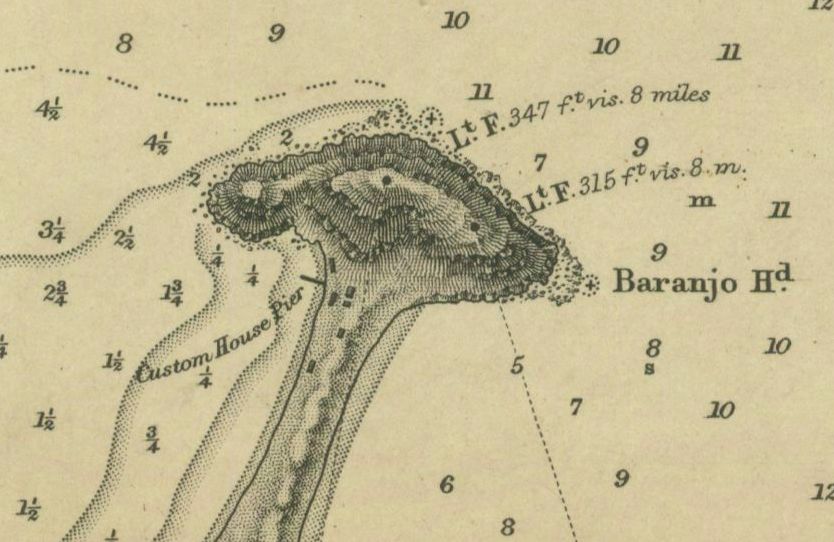
Australia East Coast - New South Wales Broken Bay [cartographic material] 1869 Edition - Surveyed by Capt. F.W. Sidney, Nav. Lieut. J.T. Gowlland & C.George Nav. Mid. R.N. 1868. Series note: British Admiralty nautical charts ; 2166 , Courtesy Stat Library of Victoria
Each tower is furnished with three lanterns lighted with kerosene, to form a fixed bright light, and will be visible at a distance of about twelve miles to seaward. From a notification to mariners in the Government Gazette, we learn that both lights will be eclipsed between the bearings of South mid S.S. E ½ E., to prevent them from being seen over the land which recedes from the Outer South Head, and also to ensure a vessel to pass a safe distance off the South Head, when running with the lights in sight for the purpose of obtaining anchorage in Broken Bay.
The lower, or outer light, will be lost sight of in rounding Barreujuey, but the upper light will be a good guide for coasters bound to Pitt Water, or for large vessels anxious to obtain shelter in Flint and Steel Bay. On Tuesday last the Thetis went down to Broken Bay, taking as passengers Captain .Myhill, Harbour Master of Port Jackson, Mr. Coles, and Mr. Robinson, the manufacturer of the lanterns, when both lights were exhibited for a short time, and their position and bearings examined from various points seaward by Captain Myhill, prior to the return of the steamer to Sydney. It was intended to have a picnic to mark the occasion of the lighting up of these two lights-which, by the way, are to be called " Stewart's Lights," after Mr. Stewart, one of the members of the Assembly for East Sydney, who has been the principal mover in the matter, and had the weather continued fine the Thetis would have gone down to the bay yesterday morning with a number of gentlemen. As the weather proved so stormy, the trip by sea had to be postponed, and Mr. Robinson, and Mr. Mulhall, who has been appointed light-keeper, went overland to light up last night. A notification for the intention to exhibit these lights has been in the papers for a fortnight, but it should undoubtedly have been given much earlier-Sydney Herald, July 21st. SHIPPING INTELLIGENCE. (1868, July 29). The Mercury(Hobart, Tas. : 1860 - 1954), p. 2. Retrieved from http://nla.gov.au/nla.news-article8853675
 THE NEW LIGHTS ON BARRENJOEY,-On Tuesday last Captain Hixson, the Superintendent of Pilots, went down to Broken Bay in the Steamer Thetis to Inspect the new lights, and which were lit up for she first time on last Monday night. He found that both lights were exhibited in terms of the notification in the Government Gazette, and he learnt from the captains of some captains that had taken shelter in the Bay that both lights burnt brightly all night, notwithstanding the wet, stormy weather, and were visible at a considerable distance at sea. Captain Hixson satisfied himself If, by actual observation in the offing, of the suitability of the position of the lights prior to his return to Sydney. SHIPS' MAILS. (1868, July 23). The Sydney Morning Herald(NSW : 1842 - 1954), p. 4. Retrieved from http://nla.gov.au/nla.news-article13169831
THE NEW LIGHTS ON BARRENJOEY,-On Tuesday last Captain Hixson, the Superintendent of Pilots, went down to Broken Bay in the Steamer Thetis to Inspect the new lights, and which were lit up for she first time on last Monday night. He found that both lights were exhibited in terms of the notification in the Government Gazette, and he learnt from the captains of some captains that had taken shelter in the Bay that both lights burnt brightly all night, notwithstanding the wet, stormy weather, and were visible at a considerable distance at sea. Captain Hixson satisfied himself If, by actual observation in the offing, of the suitability of the position of the lights prior to his return to Sydney. SHIPS' MAILS. (1868, July 23). The Sydney Morning Herald(NSW : 1842 - 1954), p. 4. Retrieved from http://nla.gov.au/nla.news-article13169831
Image: Francis Hixson with his wife Sarah and three of their four surviving sons (all in the NSW Naval Brigade) and daughters Ann, Mabel and Florence. State Library of NSW
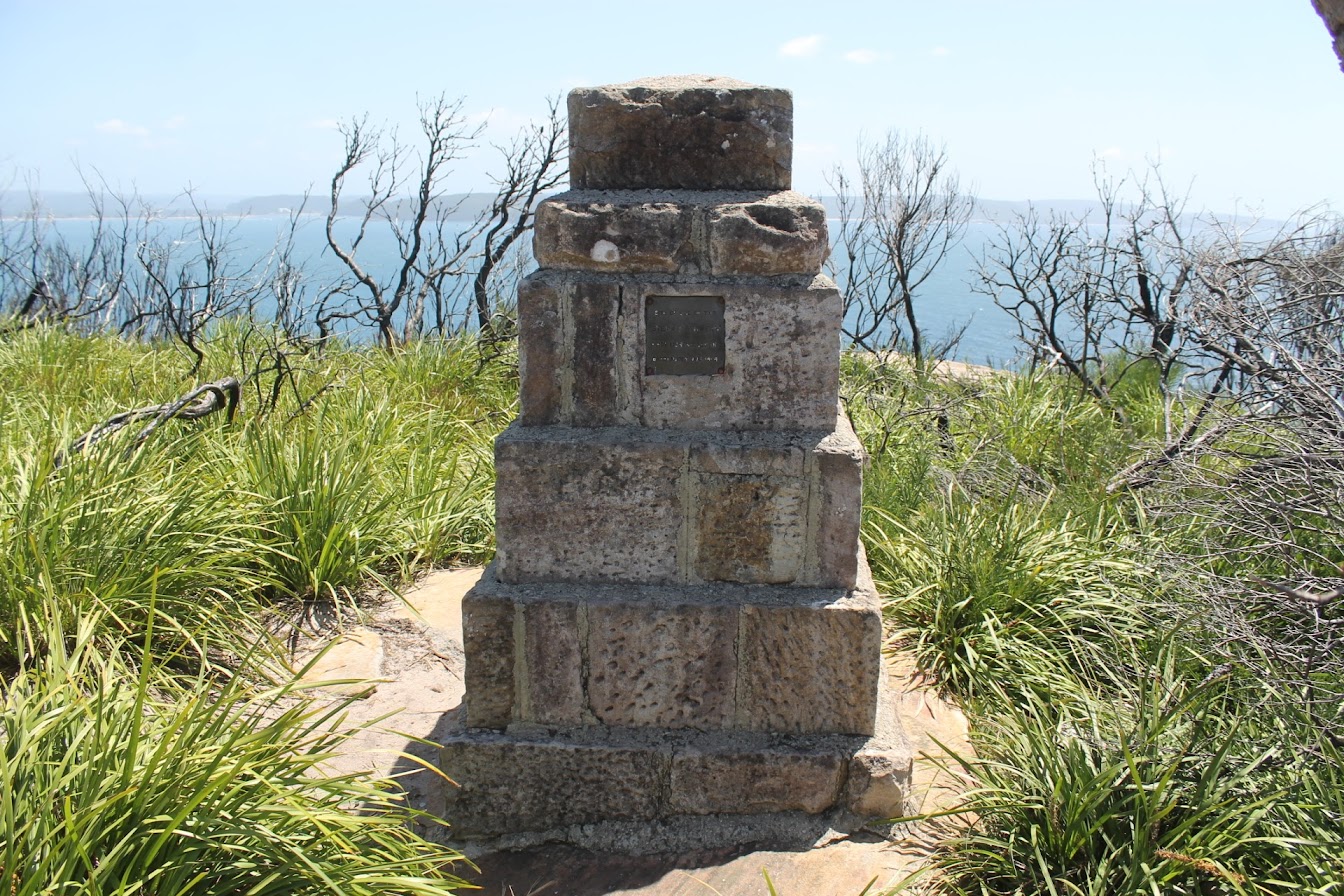
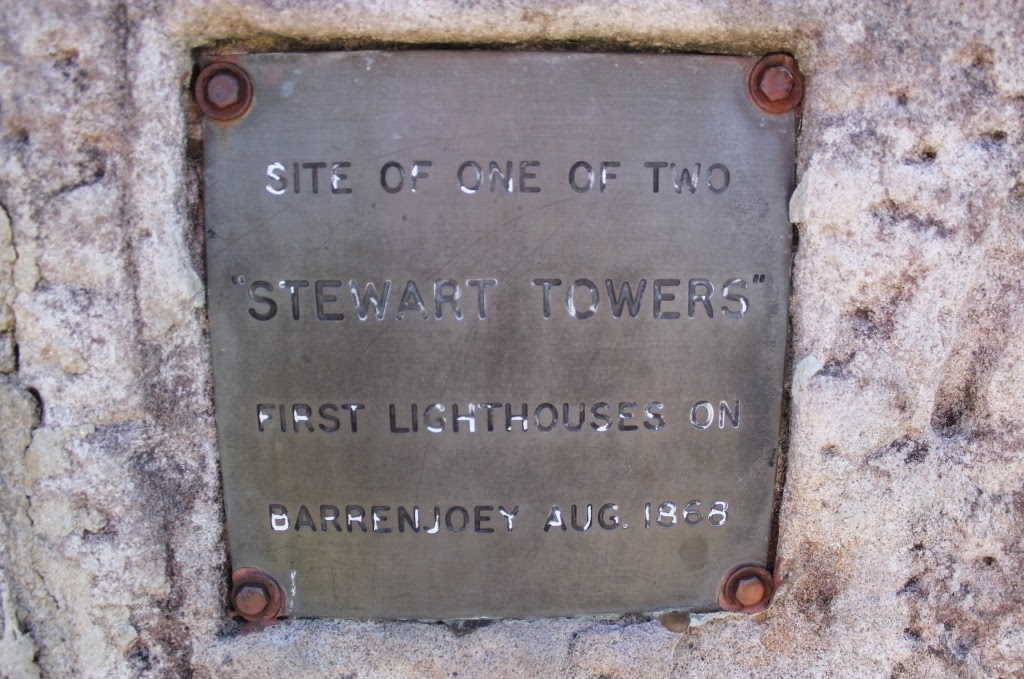
On Mr. Stewart:
DEATH OF Mr. ROBERT STEWART. General regret will be awakened by the announcement of the decease of Mr. Robert Stewart, of Sydney, formerly one of the representatives of East Sydney in the Legislative Assembly. Mr. Robert Stewart was a native of the colony, and was one of the most true hearted and consistent of our Australian-born patriots. Having been deprived, in early life, of the support and guidance of his father who was lost at sea while on an exploring trip, he struggled hard and successfully with the difficulties of his position. By sterling integrity and perseverance he won for himself a high place in the esteem of his fellow citizens; and taking an interest in the public affairs of the city and of the colony, he gradually became well known and trusted as a politician. For years he was content to work for the advancement of other public men. But the respect and confidence which the electors of Sydney entertained for him prompted them to invite him to a more distinguished position than he had sought for himself. He was returned for East Sydney, and represented that electorate for several years. As a member of Parliament, he took no prominent action in the conflicts of party; but devoted his chief attention to practical matters concerning the welfare of different classes of the people, and especially to the efficiency of the light-house system along the coast and whatever affected the safety and the social rights of our seamen. Mr. Stewart died on the 9th June, after a few days illness. DEATH OF MR. ROBERT STEWART. (1875, June 22).Clarence and Richmond Examiner and New England Advertiser (Grafton, NSW : 1859 - 1889), p. 6. Retrieved from http://nla.gov.au/nla.news-article61901957
The Stewart family lived on promised land grant of 200 acres at Broken Bay on the Hawkesbury River and left in 1831 before it had been surveyed. Robert went to Sydney c.1830 and was apprenticed as a cabinet maker and owner of a cedar yard. He eventually established a family claim to a grant at Broken Bay in 1860s.
In the years preceding this:
Among the items in the Colonial Architect's Department are the following - £3000 for additions and improvements to the Lunatic Asylum at Parramatta, £1700 for the residence of surgeon, Darlinghurst Gaol, £500 for the erection of a lighthouse at Barrenjoey, £2000 for the erection of a residence for the director of the Botanic Gardens, £1200 for repairs and alterations to the Sydney Mint, £1700 for enclosing sites of surgeon's residence, watch-house, and lunatic receiving house, Darlinghurst, and £1000 for providing additional cabinets and fittings for the Australian Museum. COUNTRY WORKS. (1867, September 21). The Sydney Morning Herald (NSW : 1842 - 1954), p. 8. Retrieved from http://nla.gov.au/nla.news-article13158058
The new lights were not without their challenges for George Mulhall, a fit man who was then a champion rower and boatman on Sydney Harbour:
BARRENJOEY LIGHTS. Mr. WINDEYER called the attention of the Government, and especially of the Treasurer, to the lights at Barrenjoey. There were two lights, which were a quarter of a mile apart, and the keeper's house was but at a considerable distance from them. There was a necessity for another person to aid him. It was a rule in the United Kingdom that there should be three men for every island or rock lighthouse. In this case there are two lights at a considerable distance, and there is enormous labour involved in keeping up these two lights. The keeper often has to remain exposed to wind and rain all night. (Mr. HILL, : Hear, hear.) He has to light the lights from the outside, which is almost impossible when the weather is rough. And instead of receiving the same remuneration as other lighthouse keepers, namely, £180 a year, he only receives only £150 a year. There was even more danger than before the lights were put up for captains would, of course, expect to see the lights there. He moved the adjournment of the house. Mr. SAMUEL said he would inquire further into the subject. The Superintendent of Lighthouses had recommended that this man's salary should be raised but he considered that ho ought to perform all the duties. The Government contemplated the erection of a permanent lighthouse there. But some delay had arisen from a dispute about the title of the land. PARLIAMENT. (1870, March 9). Empire (Sydney, NSW : 1850 - 1875), p. 3. Retrieved from http://nla.gov.au/nla.news-article60891977
Unfortunately a tragedy caused a rethink on light keeping from Barrenjoey:
BROKEN BAY. TO THE EDITOR OF THE HERALD,
Sir, will you allow me to contradict a statement which was made at a magisterial inquiry held by Mr. G. Smith of Manly Beach, concerning the death of Henry Tucker, that no tights were in the lighthouse at Barranjuie, or the boat would have safely entered.' This statement is untrue ; the two Lights were both alight, but the boat happened to approach it from the back of the screen attached to the lighthouse from where it was impossible to see the lights. The fault, therefore, does not lie with us. We saw their light in the boat harbour at different times during the night. The screen is placed in a position to prevent vessels from approaching this part of the shore, as it is dangerous. Also, if the boat had been in proper waters, the lights would have been seen by them. Please allow me to state that the accident did not happen until the following day at 5 p.m. Our lights are well seen far out at sea, and any vessel can be and is guided by them; and we are confident of no omission of their being lit at night. Several gentlemen yachtsmen, who passed the Barranjuie lights on the night in question, saw the lights clear and bright, and are ready to come forward to testify the same,
I remain, Sir, your meet obedient servant,
GEORGE MULHALL, Jun
Assistant Light Keeper. Broken Bay, December 29. BROKEN BAY. (1871, December 30). The Sydney Morning Herald (NSW : 1842 - 1954), p. 7. Retrieved from http://nla.gov.au/nla.news-article28417116
BARRANJUIE LIGHTHOUSE. TO THE EDITOR OF THE HERALD.
Sir,-I was rather surprised to find in trio Herald of Saturday, a communication wherein " George Muhall, jun," contradicts the sworn evidence of myself, J. Walker, and G. Williams, given at the inquest held on the body of the late Henry Tucker, to the effect that up till quite dark on the night in question we were not within two miles of the land, so that if the lights had been there, we must have seen them.
They were anxiously looked for, our position being a most critical one, as we had either to risk running among the Investigation to be made, and not rest satisfied with the simple denial of Mr. Mulhall. breakers on shore, or standing out to sea in a small boat on a "dark night, in a fresh southerly wind. I have spoken to an experienced yachtsman, who entered Broken Bay the same night; he confirms our statement as to there being no light visible up till 9 o'clock', I am-convinced that Mr. Mulhall will fail to bring any evidence to the contrary. We did not expect to see any light from where we were camped. As this is a matter of the greatest importance, I trust that the proper authorities will cause a strict in
I remain, Sir, your obedient servant, FRANK SMITH. BARRANJUIE LIGHTHOUSE. (1872, January 2). The
 Sydney Morning Herald (NSW : 1842 - 1954), p. 2. Retrieved from http://nla.gov.au/nla.news-article2841693
Sydney Morning Herald (NSW : 1842 - 1954), p. 2. Retrieved from http://nla.gov.au/nla.news-article2841693 Subsequent shipping disasters and the increasing frequency of trade via vessels up and down the coast increased the need for a stronger light that were not subject to prevailing storms, the times such beacons are most needed.
Then Colonial Architect James Barnet (picture at right, circa 1888)was waiting to go to work although more years lapsed between his estimates for the work and a call for tenders being advertised;
COLONIAL ARCHITECT.-A sum not exceeding L52.000, under the head " Colonial Architect, '-being L5000 for light-house, Barrenjoey, Broken Bay ; L4000 for light-house, Solitary Island ; L20,000 towards the erection of public offices ; L20,000 towards the erection of public offices (Lands department) ; and L3000 towards the erection of Custom-house, Newcastle, further sum. Loan Estimate, 1874. (1874, June 27). Australian Town and Country Journal (NSW : 1870 - 1907), p. 26. Retrieved from http://nla.gov.au/nla.news-article70475647
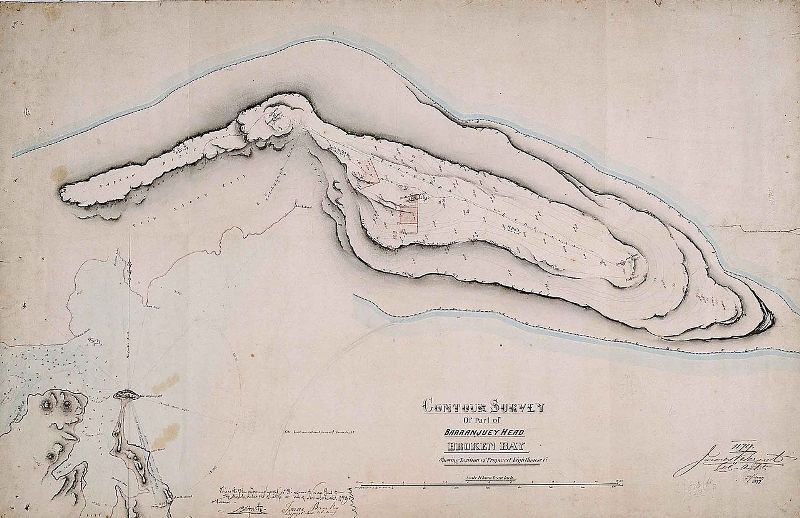
Contour survey of part of Barrenjoey Head, Broken Bay - showing position of proposed lighthouse, by James Barnet - NSW Colonial Architect, 1877. Source http://recordsearch.naa.gov.au/scripts/Imagine.asp?B=4957003
TENDERS FOR PUBLIC WORKS AND SUPPLIES.-TENDERS are invited for the following Public Works and Supplies. For full particulars see Government Gazette, a file of which is kept at every Post-office in the colony. Tenderers may be in attendance when the tenders are opened, and the name of the successful tenderer will be announced, if possible, before the duties of the Board have terminated. No tender will be taken Into consideration unless the terms of the notice are strictly complied with. The Government does not bind itself to accept the lowest or any tender. Erection of Lighthouse, Barrenjoey GOVERNMENT RAILWAYS. (1878, December 18). The Sydney Morning Herald (NSW : 1842 - 1954), p. 7. Retrieved from http://nla.gov.au/nla.news-article13426464
Until dawned the day of:
LAYING THE FOUNDATION-STONE of a NEW LIGHTHOUSE at BARRENJOEY. (BY OUR OWN REFORTEB.)
The ceremony of laying the cornerstone of the new |lighthouse at Barrenjoey was performed on Thursday, by Miss Rosa Barnet, daughter of the Colonial Architect, and everything connected therewith passed off in a highly satisfactory manner. The contractor issued invitations to several ladies and gentlemen to be present, and among those who responded thereto were Messrs. J. S. Farnell, E. Greville, and J. Hurley, M.L.A., Captain Hixson, and Messrs. Thompson, Whiting, Jeannerett, Wilson, Walker, Barnet and Spencer. Mrs. and Miss Barnet and several other ladies were also present. The party loft the Circular Quay at a quarter past 7 o'clock, in the steamer Emu, for Manly Beach, whence they were to go overland in vehicles. The morning was somewhat cloudy, and the harbour overspread with a fog. Before the steamer reached Manly, however, the fog had entirely disappeared, and the sun made an effort to beam forth through the somewhat sombre sky. Arrived at Manly, three coaches were found in waiting, which were quickly filled, and a start was then made for host Cohen's hotel, on reaching which it was announced that breakfast was awaiting us. The early hour at which most of the party had been compelled to shake off dull sleep, in order to be in time for the boat and the trip down the harbour, had rendered it quite unnecessary that the announcement should be repeated. Accordingly, we immediately wended our way upstairs to the dining-room, where a really excellent breakfast had been provided. Good humour reigned supreme. After breakfast we again took our seats in the vehicles-the ladies in one and the sterner portion of humanity in two others, and made a start on our journey proper, the vehicle containing the ladies going on first. The road for some distance, after leaving Sydney's favourite marine suburb, was dull and uninteresting ; but as we went on the features of the landscape changed, and the level tracts covered with stunted timber and brushwood gave place to undulating country, with trees of large dimensions, though evidently not of much commercial value. One conspicuous features was the number and great variety of ferns, which, after the shower of rain, looked beautiful. I almost forgot to say that just after leaving Manly rain began to fall, but it was not heavy and only lasted a short time, so that mackintoshes and umbrellas were speedily dispensed with. The sun then came out in full force, and the remainder of the day, with the exception of one very slight shower, was beautifully fine. Until Narrabeen Lagoon was reached, the journey was not productive of anything worthy of record beyond the fact that every one seemed to be m the best of spirits. The passage of the lagoon was, however, rather exciting to most of the party, from the fact that hints had been thrown out beforehand that the horses might jib, and leave us in the middle of the water before it was accomplished ; that the water was deep, and the swerving of the horses to either side might be the means of increasing the applications for space at Haslem's Creek. Notwithstanding our "critical position" the utmost coolness was observed; whilst we were crossing the ladies were assured by one gentleman in our vehicle of their perfect safety by the fact of so many " life-boys " bring close to them. A merry peal of laughter was the only reply. Frequent inquiries were made of the ladies as to whether "their feet were wet yet," as the bottom of the body of their vehicle seemed to be immersed; and it was evident that if such a calamity had happened several of our party were prepared to go to any extreme to avert its repetition. However they were not called upon to exercise their undoubted courage, or manifest other than in the way mentioned, their chivalric devotion. We got through the lagoon in safety.
The remainder of the road-or rather track was in fair order, and we made respectable progress. As we neared the end of our journey we gradually ascended a hill, on reaching the top of which a magnificent panoramic view burst upon us. At our feet lay the waters of Broken Bay, or rather that portion of it termed Pitt Water. For miles it stretched towards the entrance to the mouth of the Hawkesbury ; while, on either side, bold headlands, crowned to their summits with timber, and looking like great sentinels, rose from the water's edge. Expressions of wonder at the beauty of the scene were heard on all sides, and the fact that this lovely place is so little known to denizens of the metropolis was freely commented on.
 But our steamer, the good ship Florrie, owned by Mr. Jeannerett, was in waiting, lying alongside a jetty at the head of the bay, so we immediately embarked for our destination, Barrenjoey, a distance of about eight miles. On the opposite side of the bay is New Port, the property of Messrs. Mills and Pile and Mr. Jeannerett, who are erecting an hotel, for the accommodation of visitors to the bay. It will have a fine situation ; and when the place becomes more widely known, as it deserves to be, the hotel will doubtless be largely availed of. The trip down the bay was greatly enjoyed ; and every point of interest critically scanned. Shortly before 1 o'clock, or about on hour after leaving the wharf, we steamed opposite the jetty, at the Customs-house landing, a short distance away-the depth of water not permitting us to go alongside, and soon Mr. Black, with his whaleboat, came along-side. The whole of the party were then transferred to her, and safely taken on shore, while the provisions, ice., were conveyed in another boat. After a short stay at Mr. Black's house, we prepared to make the assent of the frowning rock upon which the lighthouse is to be erected. As it is over 300 feet high with sides almost perpendicular, the task was looked forward to with a degree of interest which all under-takings of a similar nature excite in the persons principally concerned. Fortunately for the ladies, Mr. Banks, the contractor, had a " tram-car," or rather trolly, in waiting, upon which they were to be taken to the top. It may be said here that this tramway, the rails of which are of hardwood, is a remarkable evidence of the ingenuity Mr. Banks has exhibited in overcoming the many difficulties in-separable from an undertaking of such magnitude as that of the erection of the Barrenjoey lighthouse. For sometime otter the erection of the lighthouse was decided upon it was contended that it would not be possible to have a road constructed by which the necessary materials could be conveyed from the base of the rock: to the site of the lighthouse, and that they would have to be hauled up os-or the face of the rock ; but Mr. Banks has completely upset this contention. The tramway is 1000 yards long, and is used for the conveyance of everything, except the stone, which is obtained on the top of the rock itself. It has been found invaluable for the purposes for which it was designed and constructed. It is drawn by two horses, which, it may be imagined, when it is stated that some of the gradients are 1 ni 12, have their work to do. The car or trolly is fitted with a brake, which is so powerful that the car can be stopped almost in its own length when going down the steepest incline.
But our steamer, the good ship Florrie, owned by Mr. Jeannerett, was in waiting, lying alongside a jetty at the head of the bay, so we immediately embarked for our destination, Barrenjoey, a distance of about eight miles. On the opposite side of the bay is New Port, the property of Messrs. Mills and Pile and Mr. Jeannerett, who are erecting an hotel, for the accommodation of visitors to the bay. It will have a fine situation ; and when the place becomes more widely known, as it deserves to be, the hotel will doubtless be largely availed of. The trip down the bay was greatly enjoyed ; and every point of interest critically scanned. Shortly before 1 o'clock, or about on hour after leaving the wharf, we steamed opposite the jetty, at the Customs-house landing, a short distance away-the depth of water not permitting us to go alongside, and soon Mr. Black, with his whaleboat, came along-side. The whole of the party were then transferred to her, and safely taken on shore, while the provisions, ice., were conveyed in another boat. After a short stay at Mr. Black's house, we prepared to make the assent of the frowning rock upon which the lighthouse is to be erected. As it is over 300 feet high with sides almost perpendicular, the task was looked forward to with a degree of interest which all under-takings of a similar nature excite in the persons principally concerned. Fortunately for the ladies, Mr. Banks, the contractor, had a " tram-car," or rather trolly, in waiting, upon which they were to be taken to the top. It may be said here that this tramway, the rails of which are of hardwood, is a remarkable evidence of the ingenuity Mr. Banks has exhibited in overcoming the many difficulties in-separable from an undertaking of such magnitude as that of the erection of the Barrenjoey lighthouse. For sometime otter the erection of the lighthouse was decided upon it was contended that it would not be possible to have a road constructed by which the necessary materials could be conveyed from the base of the rock: to the site of the lighthouse, and that they would have to be hauled up os-or the face of the rock ; but Mr. Banks has completely upset this contention. The tramway is 1000 yards long, and is used for the conveyance of everything, except the stone, which is obtained on the top of the rock itself. It has been found invaluable for the purposes for which it was designed and constructed. It is drawn by two horses, which, it may be imagined, when it is stated that some of the gradients are 1 ni 12, have their work to do. The car or trolly is fitted with a brake, which is so powerful that the car can be stopped almost in its own length when going down the steepest incline.
However, this is a digression. The ladies were taken up safely, though not without some misgivings on their part " that the thing would go back." It is questionable if there is along the whole-coast-line a finer view than that which is presented to the eye of the beholder from the top of this Barrenjoey. Away to the north is the north head of Broken Bay ; taking this as the beginning of a semi-circle, round towards the left Brisbane-water, the mouth of the Hawkesbury, and Pitt Water are seen in succession, with Mount Elliott (in the form of a lion couchant) guarding the entrance to the second named.
Shortly after the whole of the party reached the top due preparations were made for the ceremony. The crane and other places were decorated with bunting, while the flagstaff was "staggering" almost with flags, amongst them being the figures denoting the motto " Advance Australia," so that ships in the offing-of which there were several would be enabled to read it. After all the preparations had been completed, and the bottle containing the papers, coins, &c, had been placed in the receptacle prepared for it.
Mr. Greville said : Miss Barnet,-I have the pleasure of presenting to you, on behalf of the contractor, this mallet and silver trowel, for the purpose of laying the foundation-stone of the Barrenjoey lighthouse. They are implements small and delicate enough for such fragile hands, but yet in those hands they will be instruments for initiating a noble work. With a few light touches of this pretty piece of metal, and a few taps of too mallet, you will lay the first stone of a tower which will be the guide and safeguard of many future voyagers. Above the spot on which you stand I here will arise a noble beacon-the silent sentinel of the storm-tested mariner, the shining monitor, warning those who brave the perils of the deep to shun the more obdurate dangers of these callous rocks. A writer of great colonial reputation, and one whose untimely death will be received with the deepest regret by everyone who has had the pleasure of his acquaintance, "Peter Possum," once repeated a rendering of the old word "spea." "Spes" is usually translated by the English word âhope" but what a beautiful illustration of that translation flashes upon the mind when we discover that the literal interpretation of the Latin " spes " is a light in the distance, towards which we look and long. The light upon the tower which is soon to arise upon these rocks might fitly be called " Spes." It will be a light looked for and longed for on many a darksome night. It will be the star of hope to many a weather-beaten crew, and the saviour of many a storm-pressed ship. (Hear, hear.) It is for you, Miss Barnet, to place the first stone of that tower-a task easy in itself, but noble in its associations, and fitted well for a fair hand and a benevolent heart. (Applause.)
The mallet and trowel were then, handed to Miss Barnet, who, after the orthodox preliminaries, had been gone through, declared the stone to be well and truly laid.. On the call of Mr. Barnet, three hearty cheers were given for her Majesty the Queen, and three for his Excellency the Governor; and, on the call of Mr. Hurley, three cheers were given for Miss Barnet. The silver trowel and mallet were from the atelier of Messrs. Hardy, Brothers, and are very handsome articles. On the face of the trowel is the inscription, *' Presented to Miss Rosa Barnet upon the occasion of her laying the foundation-stone of the lighthouse at Barrenjoey, New South Wales, 15th April, 1880." The trowel is of solid silver, neatly chased, and the handle of ivory, the mallet being of tulip wood. Mr. Barnet thanked the company for the honour which they had done his daughter, which was certainly quite unexpected. He had intended to come down and see the stone laid, but did not expect any ceremony. He had, therefore, all the greater reason to thank them. (Applause.) After the ceremony had terminated, the party returned to the bottom of the rock, the ladies going as they came-on the tramway, and adjourned to Mr. Blade's house where luncheon was served up, and a most enjoyable affair it proved to be.
The necessity for a lighthouse at Barrenjoey was brought under the notice of the Government as far back as 1868, when the present site was selected as the best adapted for the purpose, but the land being private Property, with the probability of considerable delay before the Government would be enabled to take possession of it in order to meet immediate requirements, Captain Hixson, H.N., superintendent of harbours, lighthouses, and pilots, recommended the erection of two temporary wooden buildings, in which lights might be exhibited. This recommendation was approved of by the then Colonial Treasurer, the Hon. Geoffrey Bagar, the work being carried out by Messrs. Hudson, Brothers, of Sydney, at a cost of about £300, including- £35 for the two lanterns, &o'., made and supplied by Messrs. F. B. Robinson and Son, of George-street, Sydney, and completed in August, 1868. In the year 1873, at a conference of the principal officers of the Marine Departments of the Australian colonies, held in Sydney, at which Captain Hixson was unanimously elected chairman, the members of the Conference being:-New South Wales. Captain Hixson, President of the Marine Board; Queensland, Captain Heath, B.N., Chairman of the Marine Board, and Port Master; South Australia: Captain Ferguson, President of the Marine Board; Tasmania, Mr. C M. Maxwell (Warden of the Hobart Town Marine Board) ; Victoria, Captain Payne, R. N.(Chief Harbour-master and Chairman of Steam Navigation and Pilot Board); Western Australia, Captain Ferguson (President of State Marine Board of South Australia),-it was resolved to recommend the erection of a lighthouse at Barrenjoey, with light of the second order fixed red light, and in the year 1874 plans for a permanent light and quarters were prepared, and the sum of £6000 was also in that year voted towards the erection of the buildings. The matter, however, was postponed from time to time, and tenders were not invited until October, 1878, but those received being considered too high, they were declined. Ultimately, in October, 1879, the tender of Mr. Isaac Banks, amounting to £18,696, was accepted, and preparations were at once made for commencing the work. This tender, however, did not provide for the lantern and dioptric lenses which were obtained from Messrs. Chance, Brothers, of England, at a cost of £2210. The light about to be placed upon this prominent headland is of the second order of fixed dioptric red lights, with capacious well-ventilated lantern, having all modern improvements, placed in a substantial iron light-room, the whole standing upon a strong tower, 38 feet high, built with the stone of the locality. The height of the light will be 371 feet over high-water mark, and it will be visible at about eighteen miles distance. The tower will be fitted with an iron spiral stair, communicating with the upper floor. Adjoining the tower will be an oil room, with passage and exterior stairway communicating with the principal quarters. The underkeeper's quarters will be placed slightly lower on the hill to the south-west. The tower and buildings will be replete with every convenience for; the efficient working of the light. The new light will supplant the present "Stewart" lights, which have been in use for the last thirteen years. This work has been designed by the Colonial Architect of Now South Wales-Mr. James Barnet-and is being carried out under the superintendence of Mr. E. S. V. Spencer, clerk of works, and Mr. John Kelly, foreman of works; the contractor, as before stated, being Mr. Isaac Banks.
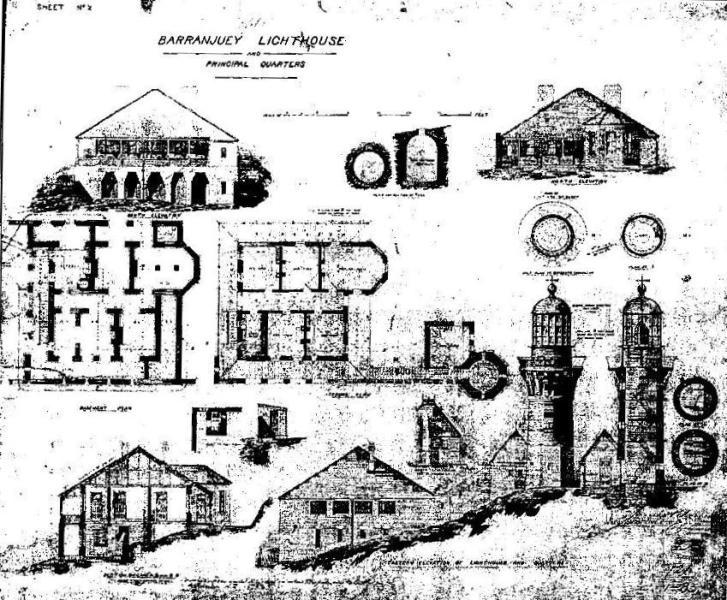
James Barnet's plan for the Barrenjuey Lighthouse and attached head Lighthouse Keepers Cottage.Source: AMSA
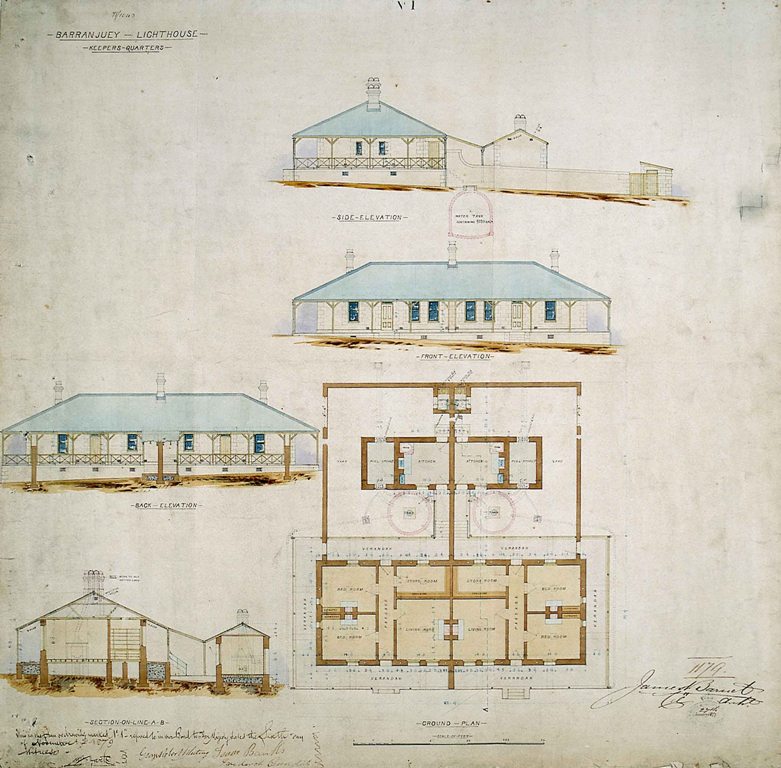
Barranjuey Lighthouse - Keepers Quarters [Barrenjoey Lighthouse] - [James Barnet - NSW Colonial Architect] - Above 1877 drawing below 1878 drawing] both from National Archives of Australia

The bottle which was placed under the stone contained a paper with the names of the Government and of the vice-regal staff; list of members of both Houses of Parliament; report of proceedings of the Marine Board Conference on lighthouses; report of the laying of the foundation-stone of Macquarie Lighthouse; Moore's Almonas ; a copy each of the Sydney Morning Herald, Sydney Mail, Echo, Evening News, Town and Country journal, Sydney Punch, Daily Telegraph, and the Illustrated Sydney News; report of the Shipwreck Relief Society, and a medallion of Queen Victoria, besides several current coins of the realm. It maybe added the site selected by the Marine Board has been so closely adhered to that the "broad-arrow " out in the solid rock, by which it was marked, appears directly in the centre of the foundations.
The arrangements for carrying on the works seem to meet all the requirements. Houses for the accommodation of the workmen have been erected on the seaward side of the isthmus which joins Barrenjoey to the mainland, and the men seem comfortable and contented.

Above: Wharf, Barrenjoey, Hawkesbury River, 1900-1910. Pic No: a116421, Courtesy of The State Library of NSW
At half-past 4 the steamer arrived, and after good-byes had been exchanged, the party were soon taken on board by the whaleboat, and a start made for home. An hour's steaming brought us alongside the wharf which we had left in the morning, where the vehicles were found drawn up in readiness. After a little time they were filled, and the land journey was proceeded with. Nothing of moment occurred on the way ; the dreaded Narrabeen was crossed in safety, and the party put down in safety at Host Cohen's Hotel, Manly, where a cup of tea was hastily partaken of and a move once more made to the wharf. Alter a pleasant trip of a little less than an hour, we were landed at the Circular Quay, having spent a day's unalloyed enjoyment. Everything connected with the trip, from first to last, had been most carefully attended to, and the result was a genuine success. LAYING the FOUNDATION-STONE of a NEW, LIGHTHOUSE at BARRENJOEY. (1880, April 17). The Sydney Morning Herald(NSW : 1842 - 1954), p. 7. Retrieved from http://nla.gov.au/nla.news-article13458288
BARRANJOEY. TUESDAY.
The masonry portion of the tower for the Broken Bay lighthouse was completed today. The rest of the work is in active progress. (FROM OUR OWN CORRESPONDENTS.) BARRANJOEY. (1880, August 11). The Sydney Morning Herald (NSW : 1842 - 1954), , p. 6. Retrieved from http://nla.gov.au/nla.news-article13465853
Two men lost their lives in the building of the Barrenjoey Lighthouse and lighthouse keepers cottages. One was William Stark who died in an onsite accident when the jib of a crane fell on him. The second, George Cobb, drowned in a boating accident. Both were buried at the original St John's The Baptist Church on the hillside overlooking Bongin Bongin Beach (now Mona Vale Beach), within the 280-hectare Bassett-Darley Pittwater Estate. Their headstones were made by their fellow workers.
Particulars of the fatal boat- accident previously reported from Barrenjoey are given. It appears that Mrs. Phillips, her son John Phillips, Joseph Modini, a fisherman, and George Cobb, a foreman in the employ of Mr. Banks, lighthouse contractor here, were returning home in a small boat, when from some unexplained cause the boat filled. Modini and John Phillips succeeded in gaining the shore about aquarter of a mile off, but Mrs. Phillips and George Cobb were drowned. Mr. Black, of H. M. Customs, immediately upon receiving information, started with a party to attempt to recover the bodies. SYDNEY. (1881, April 20). Goulburn Herald (NSW : 1881 - 1908), p. 3. Retrieved from http://nla.gov.au/nla.news-article117443807
Mr. John Kelly was Foreman of Works thereafter, and guided by Mr. E. S. W. Spencer, the then Clerk of Works. The stone used for the lighthouse, lighthouse keepers and assistant lighthouse keepers cottages was quarried from the headland itself, just below the site of the current assistant lighthouse-keeper cottages. The other materials required were brought by ship to the Customs Station Wharf and carried via the trolley devised by Mr Banks to the constructions site. The original estimate did not include the lights needed and by completion twenty thousand pounds had been spent. Build time was fourteen months, completion on July 20th, 1881.
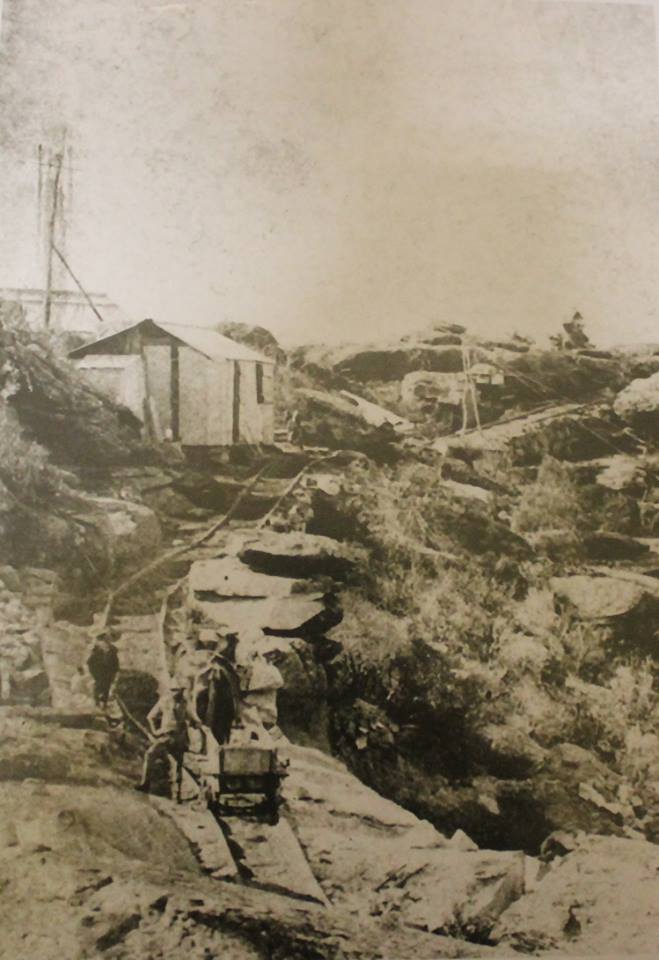
Barrenjoey July 1881 - from Australian National Archives
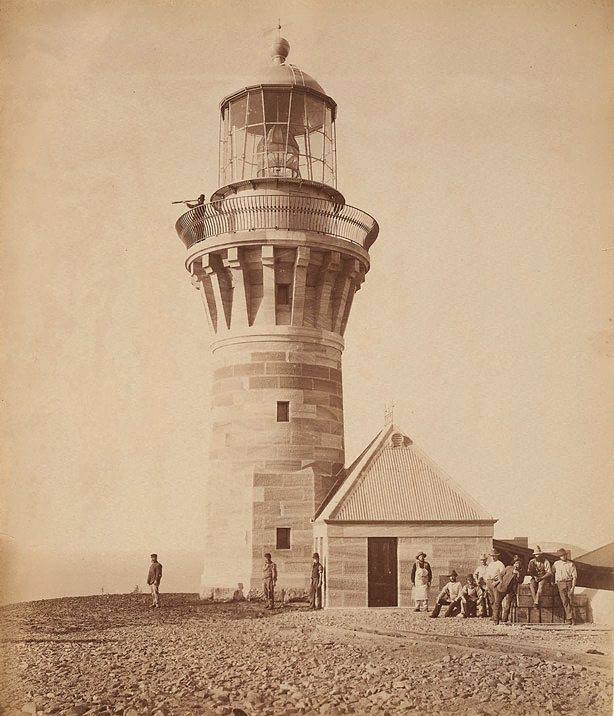
Barrenjoey Lighthouse, circa 1881 - contractors and workers - courtesy AGNSW
Of lighthouses the Colonial Architect has the completion of four under his direction. The principal one is that known as the Macquarie lighthouse, near South Head. Several months ago this reached its full height so far as the tower is concerned, but its completion has been delayed pending the arrival of the lantern from England, which has taken more time to prepare than was anticipated. This will be fitted with an electric light, which Mr. Douglas, of the Trinity Board, has written to state will be superior to any in the world. In order to make it as perfect as possible, Professor Tyndall, whose authority on light is unquestioned, was consulted. Mr. J. Elphinston is the contractor for the erection of the lighthouse, and the work is estimated to cost £11,300.
Barrenjoey lighthouse will be ready for use early in August, the building being nearly completed. A second-class red dioptric light, produced from oil, will be introduced. Mr. Banks is the contractor, and the work of erection is estimated to cost £18, 695.
 1877 -1879 Barnet Plan of the Assistant Keepers cottages for Barrenjoey Lighthouse showing the underground water tanks inside the enclosed yards (Source: NAA 4957002 Series A9568)
1877 -1879 Barnet Plan of the Assistant Keepers cottages for Barrenjoey Lighthouse showing the underground water tanks inside the enclosed yards (Source: NAA 4957002 Series A9568)
At Montague Island the quarters of the lighthouse keeper are being roofed in. The tower of the lighthouse, which is situated on a huge granite boulder, and is to be built of granite, is about ten feet out of the ground. When completed a lantern containing a first-class revolving dioptric light will be added to it.Mr. Jennings is the contractor, and the work is estimated to cost £16,950. The fourth lighthouse is situated at Green Cape, towards the southern boundary of the colony. Mr. Aspinall, the contractor, has just commenced operations, his first work being the formation of a tramway, about four miles long, from the beach to the site of the building, for the easy conveyance of materials. The lighthouse will be constructed of concrete ; the men's quarters of rubble. A first-class revolvingdioptric light will be introduced. The work is estimated to cost £12,936. Public Works in Progress. (1881, May 5). The Maitland Mercury & Hunter River General Advertiser (NSW : 1843 - 1893), p. 6. Retrieved from http://nla.gov.au/nla.news-article817064
The light shone for the first time on the 1st of August 1881.
The New Lighthouse at Barrenjuey.
{From the S. M. Herald.)
The necessity for a lighthouse at Barrenjuey, the South Head of Broken Bay, was brought under the notice of the Government as far back as 1868, when the present site was selected as the best adapted for the purpose, the land being private property. Captain Hixson, R.N., President of the Marine Board, recommended the erection of two wooden buildings in which the lights might be exhibited. This recommendation was approved of by the then Colonial Treasurer, Mr. Geoffrey Edgar, the work being carried out by Messrs. Hudson Brothers of Sydney, under the superintendence of Mr. W. Coles, first clerk of works in the Colonial Architect's department, at a cost of about £300, including £85 for two lanterns, &c, completed in August, 1868. They were named the Stewart Lights, after Mr. Robert Stewart, the then member of Parliament for East Sydney, by whose efforts these lights were established, and they have been in use for the last thirteen years.
In the year 1873, at a conference of the principal officers of the marine departments of the Australian colonies, held at Sydney, comprising Captain Hixson(chairman), representing this colony, Captain Heath, R.N., for Queensland, Captain Ferguson for South Australia and Western Australia, Captain Payne, for Victoria, and Mr. C. W. Maxwell, for Tasmania, it was resolved to recommend the erection of one lighthouse at Barrenjuey, to take the place of the two temporary lights, with lights of the second order of fixed dioptric red lights ; and in the year 1874 plans for a permanent lighthouse and quarters were prepared, and the sum of £5000 was also in that year voted towards the erection of the buildings. The matter, however, was postponed from time to time, and tenders were not accepted until October,1878. Those received being considered too high, they were declined. Ultimately in October, 1879, the tender of Mr. Isaac Banks, amounting to £13,695, was accepted, and preparations were at once made for commencing the work.
This tender, however, did not provide for the lantern light, and the light rooms, &c. The lantern was obtained from Messrs. Chance Brothers, of England, at a cost of £2210. The entire work was completed by the contractor on the 20th instant. The lantern is capacious and well ventilated, having modern improvements, placed on a substantial iron light-room, the whole standing upon a strong tower, built with the excellent freestone of the locality. The height of the light is 371 feet over high-water mark, and is visible about 15 miles distant. The tower is fitted with an iron spiral stair, communicating with the upper floor. Adjoining the tower is an oil-room, with passage, and exterior stairway communicating with the principal quarters. The under-keepers' quarters' are placed slightly lower on the hill, to the south-west, and sheltered by the north-eastern cliff. The tower and the buildings are replete with every convenience for the efficient working of the light.
These works were designed by Mr. James Barnet, the Colonial Architect, and under his direction they were carried out, the superintending officers being Mr. E. S. V. Spencer, clerk of works, and Mr. John Kelly, the mason foreman of the works. The latter left for Montague Island Lighthouse works in December, 1880, being succeeded by Mr. Archibald Murray, carpenter, from the South Solitary Lighthouse works. The light will be exhibited for the first time on the night of August 1st, by Mr. George Mulhall, the principal keeper, and his assistants. Mr. James Barnet and Captains Hixson, Broomfield, Jenkins, Robertson, M'Lean, and commander Lindeman paid an official visit to the new lighthouse on Friday, in order to inspect the works and to test the efficiency of the light from sea. They proceeded hence at noon in the Captain Cook (B.), and reached Broken Bay about 2.30 p.m., where the whole party disembarked, and made an inspection of the lighthouse and buildings, after which they re-embarked on the Captain Cook, and for the first time the lighthouse was lighted up.It was viewed from various parts of the bay, and then from the sea. Mr. Barnet expressed himself highly pleased with the work and the manner in which Mr. Banks had carried out his contract, and expressions of a similar nature were made by the members of the Marine Board, The visitors got back to Sydney at half-past 9 o'clock on Friday night, after a rather rough trip. The New Lighthouse at Barrenjuey. (1881, August 2). The Maitland Mercury & Hunter River General Advertiser (NSW : 1843 - 1893), p. 6. Retrieved, from http://nla.gov.au/nla.news-article818977
On the Opening:
THE BARRENJUEY LIGHTHOUSE.
The new lighthouse at Barrenjuey, an illustration of which appears in this issue, was lit up for the first time on Monday night, August 1, by Mr. George Mulhall, the lighthouse-keeper. On Friday an official visit was made to the lighthouse by Mr. James Barnet, and Captains Hixson. Jenkins, Broomfield, Robertson, M'Lean, and Lieut. Lindeman, R.N. The party left in the Captain Cook during the afternoon, and returned to town about 10 o'clock after a somewhat rough passage. At a conference of though principal officers of the Marine Departments of the colonies held in 1870, at which were present Captain Hixson (chairman), representing this colony, Captain Heath, R.N., for Queensland; Captain Ferguson, for South Australia and Western Australia ; Captain Payne, for "Victoria; and Mr. C. W. Maxwell for Tasmania, it was resolved to recommend the erection of one lighthouse at Barrenjuey, to take the place of the two temporary lights, with lights of the second order of fixed diopiric red lights ; and in the year 1871 plans for a permanent lighthouse and quarters were prepared, and the sum of £5000 was also voted towards the erection of the buildings. In October, 1879, the tender of Mr. Isaac Banks, amounting to £13 005, was accepted, and preparations were at once made for commencing the work. This tender, however, did not provide for the lantern light, and the light rooms, &c. The lantern was obtained from Messrs. Chance Bros., of England, at a cost of £2210. The entire work was completed by the contractor on the 20th ultimo. The lantern is capacious and well ventilated, having all modern improvements, placed on a substantial iron lightroom, the whole standing upon a strong tower, built with the excellent freestone of the locality. The height of the light is 371ft over high water mark, and is visible about 15 miles distant, latitudes 33deg 35 mins S., longitude 151deg 21min
The tower is fitted with an iron spiral stair, communicating with the upper floor. Adjoining the tower is an oil-room with passage and exterior stairway communicating with the principal quarters. The underkeepers' quarters are placed slightly lower on the hill to the south-west, and sheltered by the north-eastern cliff. The works were designed by Mr. James Barnet, the Colonial Architect, and under his direction they were carried out, the superintending officers being Mr. E. S. V. Spencer, clerk of works, and Mr. John Kelly, the mason foreman of the works. The latter loft for Montague Island lighthouse works in December, 1880, being succeeded by Mr. Archibald Murray, carpenter, from the South Solitary lighthouse works. The members of the Marine Board and Mr. S Barnet express themselves as very pleased with the manner in which Mr. Banks has carried out his contract. THE BARRENJUEY LIGHTHOUSE. (1881, August 6).Australian Town and Country Journal (Sydney, NSW : 1870 - 1907), p. 37. Retrieved from http://nla.gov.au/nla.news-article70958591
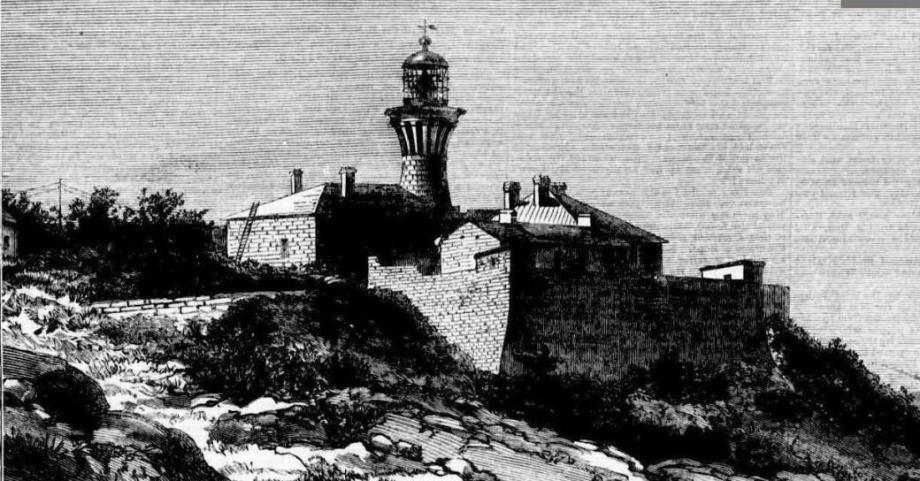
THE BARRENJUEY LIGHTHOUSE, BROKEN BAY.-OPENED ON MONDAY NIGHT. (SEE SHIPPING INTELLIGENCE.) THE BARRENJUEY LIGHTHOUSE, BROKEN BAY.OPENED ON MONDAY NIGHT. (SEE SHIPPING INTELLIGENCE.). (1881, August 6).Australian Town and Country Journal (Sydney, NSW : 1870 - 1907), p. 32. Retrieved from http://nla.gov.au/nla.news-article70958799
Subsequent notices indicate some of what was needed, accidents and maintenance and repairs in the first decades of the beacon:
Office of the Marine Board, Sydney, 20th May, 1889. TENDERS will be received at this Office up to noon of MONDAY, 27th' instant, for the supply of 20 tons of the best Screened Newcastle Coal for Barrenjoey Lighthouse. Coal to be landed on clear level space near south side of Wharf, at Pittwater. Particulars may be ascertained at this office. By order. GEO. S. LINDEMAN, Secretary. Advertising. (1889, May 25). The Sydney Morning Herald (NSW : 1842 - 1954), p. 3. Retrieved from http://nla.gov.au/nla.news-article13723897
BARRENJOEY LIGHTHOUSE. AN EXPLOSION. Captain Edie, Superintendent Department Navigation, has received a communication from the Barrenjoey lighthouse-keeper, advising that a terrific explosion took place last night at 8.15 during the storm. The floor under the verandah tower was soon in flames, but the keeper extinguished the fire before it reached the kerosene oil which is kept on the premises. All the telegraph wires were destroyed, also a long length of telephone -wire; while the keeper himself narrowly escaped accident. BARREN JOEY LIGHTHOUSE. AN EXPLOSION. (1901, January 2). Evening News (Sydney, NSW : 1869 - 1931), p. 7. Retrieved from http://nla.gov.au/nla.news-article114019571
NEW WORKS. BY PUBLIC WORKS DEPARTMENT. repairs to lighthouse, Barrenjoey, NEW WORKS. (1908, April 14). The Sydney Morning Herald(NSW : 1842 - 1954), p. 11. Retrieved from http://nla.gov.au/nla.news-article14912310
TENDERS ACCEPTED. Repairs to Lighthouse, Barrenjoey, John Devitt, The Oaks, £110 12s. New Public Works. (1908, May 4). Evening News (Sydney, NSW : 1869 - 1931), p. 4. Retrieved from http://nla.gov.au/nla.news-article112960775
GOVERNMENT CONTRACTS. TENDERS ACCEPTED. purchase and removal of 6 tons of old galvanised corrugated iron lying at Barrenjoey Lighthouse, 7 tenders-Watson and Co, £21, highest, GOVERNMENT CONTRACTS. (1909, August 24). The Sydney Morning Herald (NSW : 1842 - 1954), p. 4. Retrieved from http://nla.gov.au/nla.news-article15093612







'Pier, Barranjoey, Broken Bay' by Henry King, circa 1881-1890 - From Tyrell Collection, courtesy Powerhouse Museum

Searcy albums : Lighthouses in New South Wales, 1902, by Alfred Searcy, Barrenjoey Light, N.S.W., 1902 Digital Order No. a154002, courtesy State Library of NSW.
Barrenjoey Lighthouse - The Construction threads collected by A J Guesdon, 2013.